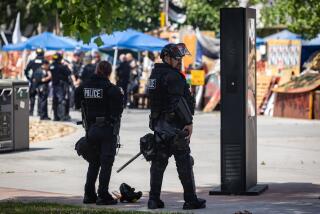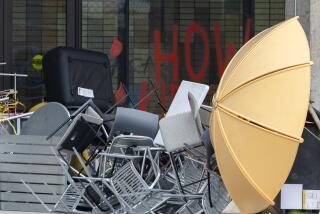Oaxaca’s streets still simmer with defiance
oaxaca, mexico — The state capital remained divided Monday, as thousands marched in defiance and others praised government forces that dislodged a protest encampment from the city center this weekend.
The recovery of the plaza by federal police late Sunday marked a symbolic end to the five-month occupation by striking teachers and leftist supporters who are demanding that the state governor resign.
But it remains unclear when the tourist capital will return to normal.
Mexican President Vicente Fox declared victory Monday, saying that “the plaza and city were recovered for the citizenry of Oaxaca.”
Although at least two deaths were reported during the 12-hour incursion by more than 4,000 riot police using armored equipment, Fox described the operation to a convention of stockholders as “bloodless” and said it was conducted without weapons.
Flavio Sosa, a leader of the leftist movement known as the Popular Assembly of the People of Oaxaca, said Monday that the government had recovered only a single city block.
“I want to tell you that we are not going to hand over control of the city,” he said in a radio interview. “We are going to resist at every barricade.”
Protesters converged on the central plaza in the early afternoon Monday in a mostly peaceful demonstration calling for the ouster of federal police and the resignation of Gov. Ulises Ruiz.
Sweltering in body armor and helmets on a hot day, the police stood impassively as some protesters pleaded for them to join their cause, and others insulted the officers’ mothers and manhood.
“How quickly you forget the villages where you come from,” said a woman, wagging a finger at police.
The protesters’ grievances stem from the desperate poverty in this southern state, especially among the indigenous people, who are among the poorest and least educated in Mexico.
“All we want is work, hospitals, better schools and the military out,” said Veralisa Flores, a teacher who marched with friends. “This is a peaceful movement.”
Rogue elements have damaged the image of the fledgling movement, as well as that of the local government.
Over the weekend authorities announced the arrest of five men in Friday’s slaying of American journalist Bradley Roland Will, including the police chief and two of his officers from nearby Santa Lucia del Camino.
Many residents who visited the plaza early Monday said they hoped the arrival of federal police would be the first step in bringing Oaxaca back to normal.
“The majority of people are relieved the police are finally here,” said Gloria Crisantos, who with her family brought bottles of water to police officers. “We’ve been held hostage in our own city. Look around. Ask anyone.”
As if on cue, a crowd of passers-by gathered, eager to voice their support for police. They said they had lost business and jobs, and that their children had been out of school since May.
Meanwhile, both houses of Congress voted Monday to ask Ruiz to resign or take a leave of absence.
“How can he show his face in town again after all this?” said a woman, pointing to a burned-out shell of a bus blocking a downtown street.
Ruiz said Monday at a news conference in Oaxaca that he would not resign.
There were signs of a tourist town coming back to life, even with most of the downtown shops closed.
John Kristel, 16, of Maui posed in front of a line of police officers as his family snapped photos.
His impressions of Oaxaca?
“It’s, like, exciting,” he said.
*
sam.enriquez@latimes.com
Times staff writer Hector Tobar and Carlos Martinez of The Times’ Mexico City Bureau contributed to this report.
More to Read
Sign up for Essential California
The most important California stories and recommendations in your inbox every morning.
You may occasionally receive promotional content from the Los Angeles Times.










